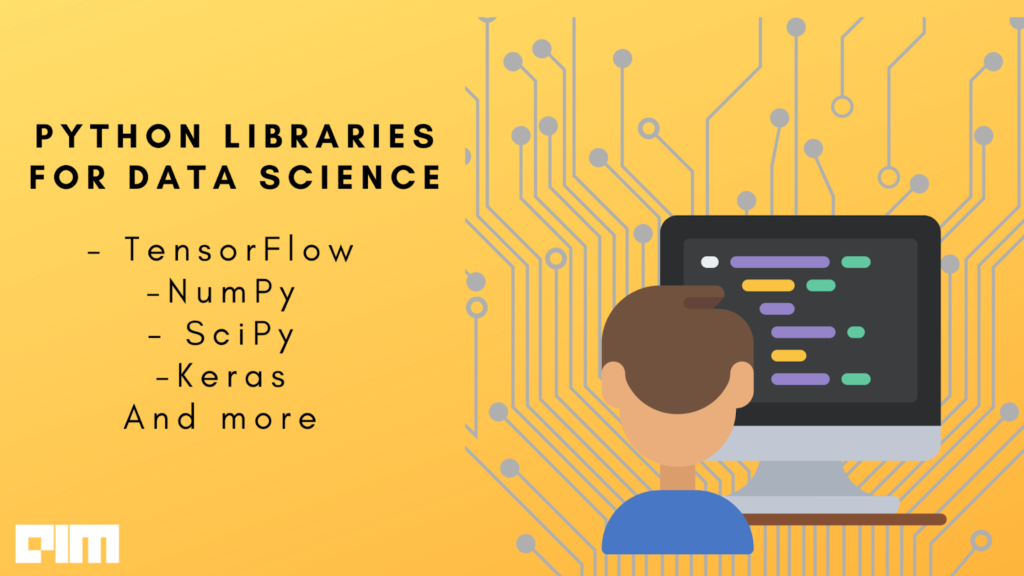Python is an interpreted, interactive, portable and object-oriented programming language. This open-sourced general-purpose language runs on many Unix variants, including Linux and macOS, and Windows. Python has applications in hacking, computer vision, data visualisation, 3D Machine Learning, robotics, and is a favourite of developers worldwide.
Below, we list the ten most popularly used Python libraries for Data Science:
TensorFlow
Developed by Google Brain Team, TensorFlow is an open-source library used for deep learning applications. Originally developed for numerical compilations, it offers a comprehensive and flexible ecosystem of tools, libraries and community resources, enabling developers to build and deploy ML-based applications. First released in 2015, the Google Brain team recently launched its latest version, TensorFlow 2.5.0 with more features. It supports Python 3.9.
To know more, click here.
NumPy
Developed by Travis Oliphant in 2015, NumPy or Numerical Python is a fundamental library for mathematical and scientific computations. The open-source software has functions of linear algebra, Fourier transform, and matrix computations and is mainly used for applications where speed and resources are important. NumPy aims to provide array objects 50x faster than traditional Python lists.
Data science libraries including SciPy, Matplotlib, Pandas, Scikit-Learn and Statsmodels are built on top of NumPy.
To know more, click here.
SciPy
SciPy or Scientific Python is used for complex mathematics, science and engineering problems. It is built on the NumPy extension and allows developers to manipulate and visualise data.
SciPy provides user-friendly and efficient numerical routines for linear algebra, statistics, integration and optimisation. Its applications include multidimensional image processing, solving Fourier transforms and differential equations.
To know more, click here.
Matplotlib
Developed by John Hunter, Matplotlib is one of the most common libraries in the Python community. It is used for creating static, animated and interactive data visualisations. Matplotlib provides endless customisation and charts. It enables developers to use histograms to scatter, customise and configure plots. The open-source library offers an object-oriented API for integrating plots into applications.
To know more, click here.
Pandas
Developed by Wes McKinney, Pandas is used for data manipulation and analyses. It provides fast, flexible and expressive data structures and provides features such as handling of missing data, fancy indexing and data alignment.
Pandas provides fast, flexible and expressive data structures that helps developers work with labelled and relational data. It is based on two main data structures– Series, and Frames.
To know more, click here.
Keras
Open-source software library Keras provides an interface for the TensorFlow library and enables fast experimentation with deep neural networks. It was developed by Francois Chollet and was first released in 2015.
Keras offers utilities for compiling models, graph visualisation and dataset analysis. Further, it offers prelabeled datasets that can be imported and loaded directly. It is user-friendly, versatile and suited for creative research.
To know more, click here.
SciKit-Learn
SciKit-Learn features classification, regression and clustering algorithms, including DBSCAN, gradient boosting, support vector machines and random forests. David Cournapeau built the library on top of SciPy, NumPy and Matplotlib for handling standard machine learning and data mining applications.
SciKit-Learn is an effective tool for predictive data analysis.
To know more, click here.
Statsmodels
Statsmodels is part of the Python scientific stack, oriented towards data science, data analysis and statistics. It is built on top of NumPy and SciPy and integrates with Pandas for data handling. Statsmodels allows users to explore data, estimate statistical models and perform statistical tests.
To know more, click here.
Plotly
Plotly is a collaborative, web-based analytics and graphing platform. It is one of the most powerful libraries for ML, data science and AI-related operations. Plotly is publication-ready and immersive and is used for data visualisation.
Plotly can easily import data to chart, allowing developers to make slide decks and dashboards with ease. It is used for the development of tools like Dash and Chart Studio.
To know more, click here.
Seaborn
Seaborn is Python’s most commonly used library for statistical data visualisation, used for heatmaps and visualisations that summarise data and depict distributions. It is based on Matplotlib and can be used on both data frames and arrays.
Seaborn is used for basic plottings– bar graph, line charts and pie charts.
To know more, click here.

























